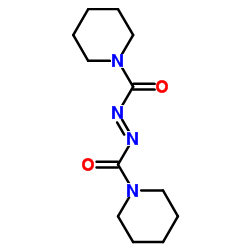Radiosensitization by diamide analogs and arsenicals.
E A Bump, G P Jacobs, W W Lee, J M Brown
文献索引:Int. J. Radiat. Oncol. Biol. Phys. 12(8) , 1533-5, (1986)
全文:HTML全文
摘要
Several analogs of the glutathione (GSH) oxidizing reagent diamide [diazenedicarboxylic acid bis(N,N'-diethylamide)] were tested as radiosensitizers of aerobic cells. In general, radiosensitization correlates with the rate of reaction with cellular reducing agents and occurs only when the reductive capacity of the cell is exceeded. SR-4077, [diazenedicarboxylic acid bis(N,N-piperidide)], is particularly suitable for mechanistic studies, because it is less cytotoxic than diamide, but is equally reactive toward cellular GSH. SR-4077 sensitizes CHO cells to X rays under aerobic conditions, even when the drug is added after irradiation. Radiosensitization is expressed both as a change in the exponential slope of the radiation cell survival curve and as a decrease in the shoulder of the survival curve. Phenylarsine oxide, a dithiol-binding reagent, sensitizes aerobic CHO cells to X rays by modification of the shoulder of the survival curve. The results are consistent with the hypothesis that the shoulder-modifying effect of GSH oxidants is caused by the loss of protein thiols, which might be involved in the repair of X ray-induced DNA damage.
相关化合物
| 结构式 | 名称/CAS号 | 分子式 | 全部文献 |
|---|---|---|---|
 |
1,1'-(偶氮二羰基)二哌啶
CAS:10465-81-3 |
C12H20N4O2 |
|
Copper salt catalyzed addition of arylboronic acids to azodi...
2005-10-14 [J. Org. Chem. 70 , 8631, (2005)] |
|
Structure--activity relationships of 1beta-methyl-2-(5-pheny...
2002-05-01 [Bioorg. Med. Chem. 10 , 1595, (2002)] |
|
Radiosensitization, thiol oxidation, and inhibition of DNA r...
1988-02-01 [Radiat. Res. 113 , 346, (1988)] |
|
Novel concepts in modification of radiation sensitivity.
1994-05-15 [Int. J. Radiat. Oncol. Biol. Phys. 29(2) , 249-53, (1994)] |
|
Dougherty, J.M.; et al.
[Tetrahedron 61 , 6218, (2005)] |